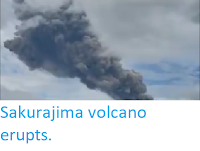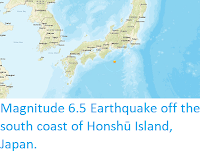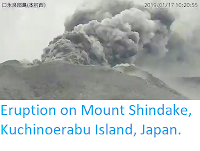Four people have died and another one is missing in Chibu Prefecture, Japan, in a series of events linked to Typhoon Bualoi on Friday 25 October 2019. The typhoon has not made landfall in Japan, but instead has been moving northward of the country's east coast, bringing widespread rains and flooding. A woman in her sixties is dead and another in her forties is missing after a landslide struck two houses. Landslides
are a common problem after severe weather events, as excess pore water
pressure can overcome cohesion in soil and sediments, allowing them to
flow like liquids. Approximately 90% of all landslides are caused by
heavy rainfall. A separate landslide is reported to have claimed the life of a man, while two elderly men are reported to have drowned in separate incidents, one of them in his car. Flood warnings are in place across a broad swath of eastern and central Japan, with over 395 000 people in low lying areas advised to evacuate their homes.
Typhoon Bualoi off the coast of Japan. Joint Typhoon Warning Center.
Tropical storms are caused by solar energy heating the air above the oceans, which causes the air to rise leading to an inrush of air. If this happens over a large enough area the in rushing air will start to circulate, as the rotation of the Earth causes the winds closer to the equator to move eastwards compared to those further away (the Coriolis Effect). This leads to tropical storms rotating clockwise in the southern hemisphere and anticlockwise in the northern hemisphere.These storms tend to grow in strength as they move across the ocean and lose it as they pass over land (this is not completely true: many tropical storms peter out without reaching land due to wider atmospheric patterns), since the land tends to absorb solar energy while the sea reflects it. Such storms have different names in different parts of the world, with those in the western Pacific and Indian Ocean being known as Typhoons.
The path and strength of Typhoon Bualoi. Thick line indicates the
past path of the storm (till 6.00 pm GMT on Friday 25 October 2019), while the thin line indicates the predicted future path of the storm,
and the dotted circles the margin of error at twelce and twenty four hours ahead. Colour indicated the severity of the storm. Tropical Storm Risk.
Despite the obvious danger of winds of this speed, which can physically
blow people, and other large objects, away as well as damaging buildings
and uprooting trees, the real danger from these storms comes from the
flooding they bring. Each drop millibar drop in air-pressure leads to an
approximate 1 cm rise in sea level, with big tropical storms capable of
causing a storm surge of several meters. This is always accompanied by
heavy rainfall, since warm air over the ocean leads to evaporation of
sea water, which is then carried with the storm. These combined often
lead to catastrophic flooding in areas hit by tropical storms.
See also...
Follow Sciency Thoughts on Facebook.
Bualoi








